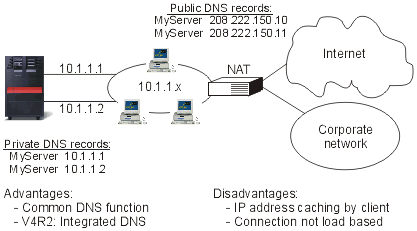You can use DNS-based load balancing for your inbound workload. If load balancing is needed for local clients, use DNS load balancing.
DNS-based load balancing is used for inbound load balancing. Multiple host IP addresses are configured in DNS for a single host server name. DNS alternates the host IP address returned to a successive client host name resolution request. An advantage to this type of load balancing is that it is a common DNS function. Disadvantages to this solution are that IP addresses can be cached by a client and it is a connection-based solution, not a load-based solution.
The first way to achieve load balancing is to use a DNS function to pass out multiple addresses for the same system name. The DNS will serve a different IP address each time a request is made for the address record for your system name. In the following example, each address corresponds to a different system. This allows you to provide load balancing across two separate systems. In the case of clients on the private networks, they receive a different address for each request. This is a common DNS function. Notice that the public DNS also has two address entries. These addresses are translated using static NAT so that if you are on the Internet, you can reach the two systems.

If your programs depend on getting to a specific system or depend on returning to the same system after the initial connection, the Web pages and site should be coded to send a different system name after the first contact is made. Additional DNS entries can be added for MyServer1 208.222.150.10 and MyServer2 208.222.150.11. By doing this, the Web sites, for example, can point to MyServer2 after the first contact. This type of load balancing provides balancing by the connection request. In most cases, after you have resolved the address the client caches the address and will not ask again. This type of load balancing does not consider the amount of traffic going to each system. Note that this type of load balancing only considers inbound traffic and also that you can have two adapters on one system rather than one adapter on two systems.